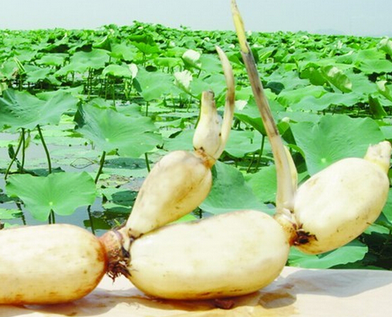Lotus root cultivation and pest control techniques
1. Putian selection
Choose leeward to the sun, convenient irrigation and drainage, 20-30cm of farming layer, fertile field with plow bottom layer for the field. The pond species requires a water depth of no more than 1 m, the water level is relatively stable, and there is a plow floor.
2, fertilizing the field
For example, in the area of ​​25° north latitude and 1300m above sea level, the lotus root planting time is around the spring equinox. Therefore, after the convulsions, the base fertilizer can be applied to the whole field. The base fertilizer is mainly organic fertilizer, with a fertilizer of 22,500-37,500 kg per hectare and 750 kg of compound fertilizer. It is particularly noted that Putian cannot apply ammonium bicarbonate and paulownia.

3, planting
The oblique insertion method is adopted, that the hoe is buried in the mud 10-13cm, the tail section is slightly tilted on the water, the row spacing is 2mx2m or 2mx2.5m, and the seed amount per hectare is 3000-4500kg. If you reserve a breeding field, the density can be increased. When planting, the direction of the hoe is best to cross between the nests, and the marginal line should be in the direction of Shuntian, always pointing the hoe to Tian Hao. Because lotus root growth generally grows along the direction of the hoe, this planting method is beneficial for crusting and growth.
4. Field management
Cultivating weeding
From the planting to the long leaves of the lotus leaves, it is necessary to timely weed and weed 2-3 times, the first time before the lotus leaf buds, the second time after the emergence of the floating leaves, the third time after the leaves.
top dressing
In the lotus root growth season, according to the growth of timely application of quick-acting fertilizer, it is generally necessary to apply top dressing 2 times. For the first time, when the 1-2 leaves were just released, the urea was applied 112.5-150kg per hectare; the second time before the closure, 75-112.5kg of urea per hectare was added and 225-300kg of potassium fertilizer was added. The decomposed cake fertilizer or farmyard fertilizer can be used as top dressing.
Water level adjustment
Lotus roots have different requirements for water in different growth stages. The water level should be controlled from shallow to deep and then from deep to shallow. Planting until the vertical leaves extend 5-10cm water level, the standing leaves reach before the knot, with the growth of the standing leaves, the water level can be increased to 30-60cm, the water level in the scarring period drops to about 5cm. Drain the water 15-20 days before picking to facilitate picking.
Pest Control
Lotus root virus disease. Control methods: pay attention to the selection of disease-resistant varieties; strengthen the investigation, once the first-infected plants are found, they should be dug as soon as possible, and the bamboo seeds should be inserted into the excavated diseased plants to monitor the disease, and the nearby plants should not be left at the time of harvest. Seedlings; grasp the phlegm and cure phlegm; spray the foliar nutrient (such as potassium dihydrogen phosphate, foliar treasure, etc.) plus 0.05%-0.1% black soap or laundry soap, or 5% toxic water clearing agent 300 times solution or 100 times solution of Ns-83 antagonist. Spray even 2-3 times or more, spray once every 10-15d to passivate the poison source, promote plant growth, reduce the incidence; choose the seedling from the disease-free field.
The small sclerotium leaf rot of lotus root leaves. Control methods: There is no mature prevention and treatment experience. It is recommended to apply 5% Jinggangmycin aqueous solution or soluble powder 500-1000 times solution or 20% fluprosamine in spraying or pouring method in the field with serious disease. Wangjiaduo) wettable powder 800-1000 times liquid, or 50% non-fertilizer (vinyl bacteria core) wettable powder 1000-1300 times liquid, or 30% double raw milk 1000 times liquid, or 50% enemy fungicide Wet powder 500 times solution. Spray even 2-3 times, spray once every 7-15d, alternately apply, before and after the dense. If you use the pouring method. The amount of the above liquid should be doubled, diluted with water and applied for safety. Reduce the water level to the shallow water layer as much as possible before application, and return to the required water level after 24 to 48 hours of application.
Pests. Lotus root tuber, rice root leaf beetle and Spodoptera litura are the main pests of Putian, which can be controlled by the general low-toxic and high-efficiency insecticides in the initial stage.
5, harvest
Entering the autumn and winter, the aboveground part stops growing and gradually wilting. It is the best time to harvest lotus roots. If it is affected by the processing and sales schedule and cannot be harvested in time, it will be collected until the next spring equinox. Before harvesting, the stalks are drained in advance, and the mud is not enough, and the chicken claws are slightly broken. When picking the hoe, you only need to gently open the soil along the direction of the lotus root growth (that is, the direction in which the hoe is pointed when planting). When picking, you can start from the beginning of the field, try to avoid blind shovel excavation or picking up the soil when the field is not dry, so that the lotus root harvesting is complete, increase the yield, and minimize the damage to better maintain Its commercial nature.
Bagged Solid Beverage,Bagged Solid Powder,Bagged Grass Powder,Organic Grass Powder In Bags
Hengshui Shanzhi Health Drink Co., Ltd , https://www.grasspowder-sz.com